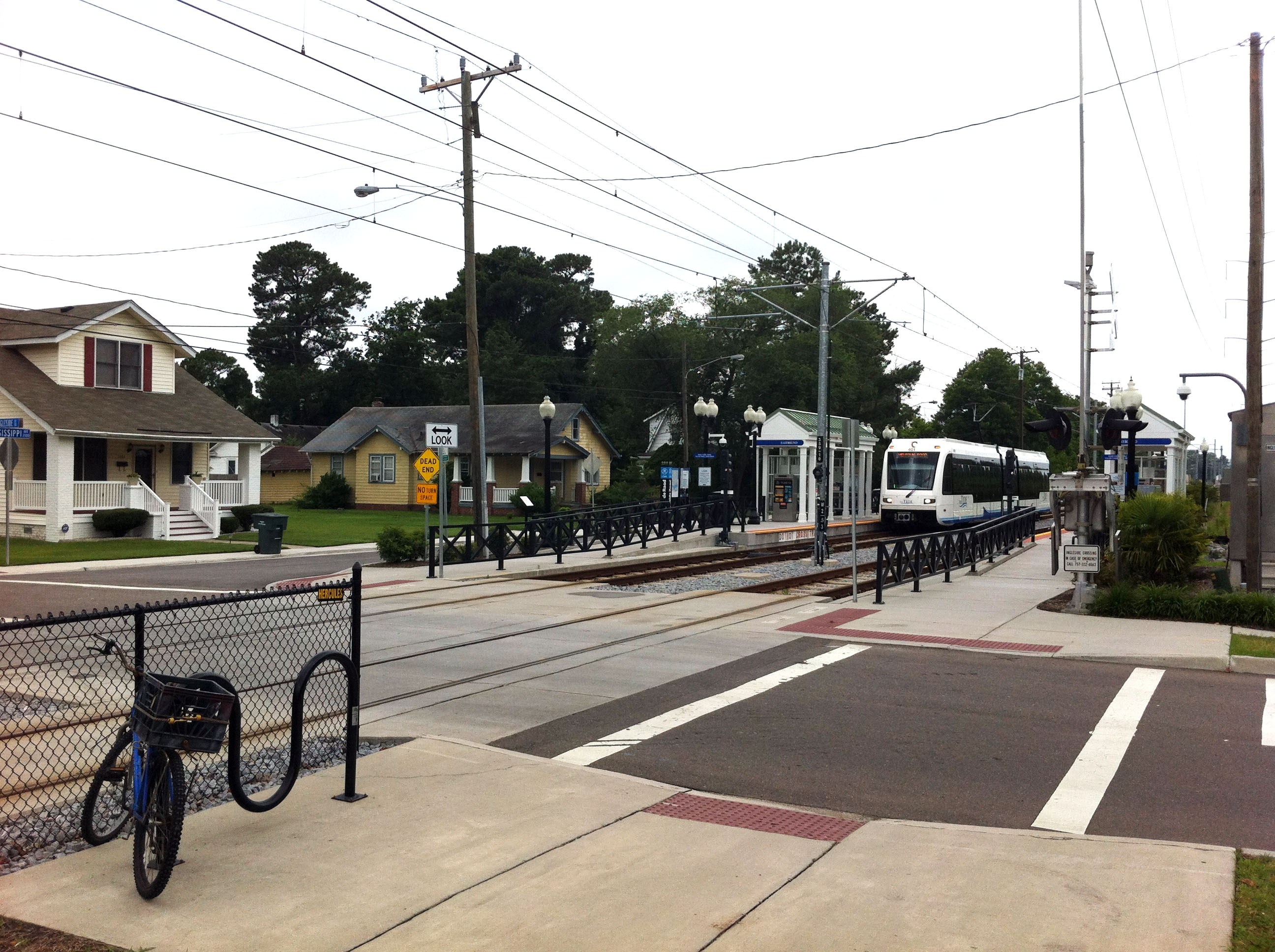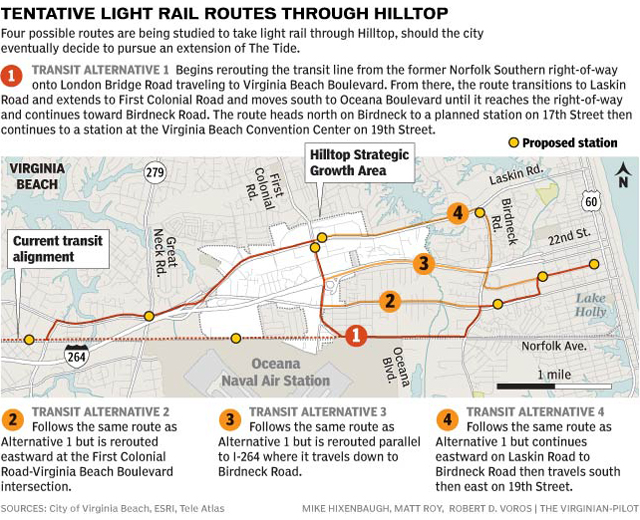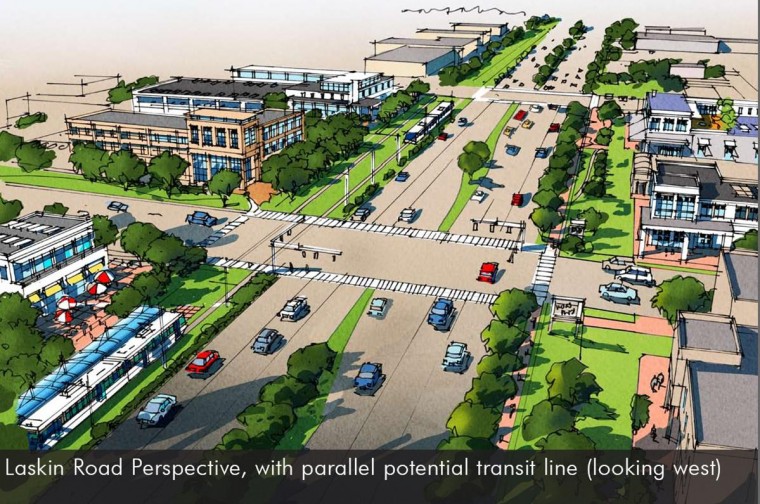You are currently browsing all posts tagged with 'HRT'.
Light Rail and Wal-Mart are from different planets!
posted on Wednesday, June 19th, 2013 at 3:33 pmPlanning and academic research on the subject of property value changes due to the presence of a nearby Light Rail station consistently documents a positive investment opportunity, especially for commercial property and apartments.

There was an article on the second page of the Virginia Pilot in the June 8th issue, relaying a story about a new Wal-Mart and Wawa coming to the intersection of Ingleside Road and Princess Anne Road in Norfolk. My first thought was, “Does this investment have anything to do with the proximity of the Ingleside Light Rail station for The Tide?”
The article compared the proposed Wal-Mart at Ingleside to a so-called “Neighborhood Market” on Holland Road in Virginia Beach. A typical Wal-Mart store does tend to look and operate like the Holland Road Marketplace. That project would be more aptly be described as an “Un-neighborly Marketplace” since walking there from a nearby house or apartment is to be faced with traversing a wasteland of parking areas and driving aisles. I am open to the possibility that Wal-Mart and Light Rail could be designed to be mutually supportive but the comparison to the Holland Road Marketplace translates to more of the same.
City planners can sometimes influence the design of a large commercial project. They cannot however, transform the design from a big box store to become a truly pedestrian-friendly “Neighborhood Market” project. This project is likely to look and function like the Holland Road Marketplace to which the article writer refers. (That site was formerly a giant Super K-Mart that was closed a few years back.)
The proposed Wal-Mart project is not likely to be a positive influence on the surrounding neighborhood at Ingleside and Princess Anne roads, in terms of becoming a better place to live. There is already another Wal-Mart center about 3 miles away, next to the JANAF shopping center, whereas the proposed new location is 1.7 miles from the Ingleside Light Rail station. Sadly, there is no pedestrian linkage between the two. Distance is not the only obstacle to overcome for Ingleside Road to be imagined as a walking path to the new Wal-Mart, since there is also Norfolk Industrial park that lies along the route.
I believe the presence of light rail is the single most direct opportunity to influence proper urban patterns into the future. As gasoline prices climb upward to the level that they are in Europe already ($12 per gallon) development choices are going to need to be made that do not depend on the private automobile to the extent that has been during the 20th century. We can begin now to make development choices that will shape our urban environments to function more like European cities. Pick your favorite European city and notice how important fixed route public transportation is to the pleasure of the place.

Weighing the pluses and minuses of this prospective Wal-Mart at Ingleside Road and Princess Anne Road, I can see that the new Wal-Mart is good for the tax base of the City of Norfolk, and would provide some new jobs in the area. Another plus is that this Wal-MartCenter has two HRT bus routes within a half mile radius.
By having these bus routes close to the Wal-Mart, they make this proposed site an infill property that is well integrated into the fabric of the existing public transportation systems. Even if the City Planners succeeded in helping the new Wal-Mart appear to be a pedestrian destination instead of another automobile oasis, it is not walkable to the surrounding residents.
I would like to see the stops for The Tide light rail surrounded by small retail establishments that can service the commuters. When stations provide parking spaces for commuters, retail businesses see advantages in locating to those areas. A treed park could pop into the picture, and pretty soon nearby residents would go to those areas for reasons other than to board the light rail. The criteria for selecting stops for new light rail routes should strongly take into consideration intersections where there is already some element of pedestrian activity. The Wal-Mart at Ingleside and Princess Anne Road will do nothing positive for its surrounding neighborhoods. Neither does it contribute to stimulate any pedestrian dynamics for the light rail station at Ingleside Road.
The presence of the Tide light rail station stop at Ingleside Road and the proposed Wal-Mart at Ingleside are too far apart to have a pedestrian relationship, too economically detached have common goals for the surrounding neighborhoods. It’s more like they come from different planets and chanced to land on the same road.
Tags: Hampton Roads Transit, Holland Road, HRT, Ingleside Road, Kroger Marketplace, Light Rail, new urbanism, Norfolk, pedestrian, public transportation, sustainability, The Tide, VA, Virginia, virginia beach, Wal-Mart, walkable
Selecting an established commercial hub is a prime Light Rail station stop
posted on Saturday, June 2nd, 2012 at 8:27 pmThe idea of diverting the LR route from the rail Right of Way to the service access roads at Hilltop came from a resident participant at the Strategic Growth Area public forum. That was only last month. The consultant has already offered alternate routes, how responsive is that? Bravo!
The best thing about the extension of light rail to the Virginia Beach resort area is the development patterns that will be anchored at the selected station stops. To quote an article regarding the settlement pattern improvements resulting from the introduction of the new Metro Light Rail in Phoenix: “…they (station stops) draw development around them and with it people, density, culture and business vibrancy …a place where local color develops and evolves at a greater speed and depth than sleeper communities.”
It seems to me that the benefits of improving neighborhood places (insert Hilltop) to become more “centralized, sustainable, and walkable” is accelerated by choosing it as a light rail station stop. If there is a flaw with the vision of The Tide in Norfolk it is that the choice of station stops outside of the CBD. They are “sleepers”. The neighborhood development opportunities at Newtown Road, for example, are enormous and there is nothing there yet.
I continue to be frustrated with the banter that gets published in the newspaper that reduces the discussion of the extension of light rail to Virginia Beach as a matter of public investment accounting. Pubic policy makers (federal, state and local) are currently accustomed to making decisions to subsidize highways almost exclusively. Those expenditure decisions benefit oil companies, automobile makers, and tunnel contractors, as we are painfully aware. What about us? the citizens of Hampton Roads. What do we want?
I am grateful that we will get our day in the voting booth to voice our choice for an alternative to the proliferation of everything associated with dependence on the private automobile as our only means of transportation. I believe that the citizen’s perspective of the best alternatives for transportation investment in the future is more far-sighted than the transportation establishment. The current policy makers view has resulted in funding a 2.1 billion dollar midtown tunnel project. A better choice would have been to extend a light rail tube into Portsmouth.
Budgeting our precious public funds to extend highways and enlarge tunnels results in more roadways that inevitably become clogged with ever greater numbers of automobiles (contributing to air pollution, traffic congestion, accidents and lost time commuting). These expenditures consume vast amounts of vacant land for more and wider roads, thereby creating the need for further expenditures of tax monies to handle storm water runoff, landscape maintenance and noise separation barriers.
The choice for highway investment promotes wasteful low-density residential developments of architectural monotony, encouraging “look alike” subdivisions of single-family units separated by individual driveways with cars parked in front yards.
The choice for highway investment promotes an automobile oriented shopping centers surrounded by acres and acres of pavement that require a car to reach. It is reported that the capital cost to the local government of a parking space at a shopping center is currently $8,000. What is the public value of that expense?
Light rail is the logical alternative to exclusive investment in providing for the private automobile. It is almost like a prophesy for the future of Hampton Roads that the citizens should be the voice of vision that gives it life.
Tags: Hampton Roads, Hampton Roads Transit, Hilltop, HRT, Light Rail, Light Rail Extension, Metro Light Rail, Phoenix, public transportation, virginia beach
Light Rail extension into Virginia Beach, sooner, rather than later
posted on Sunday, February 5th, 2012 at 9:51 pmDoes a proper vision of the future form of Hampton Roads include light rail transit? The question is more controversial than I imagined, most recently triggered by the story in the Virginia Pilot that there could be a referendum in November for the extension of the Tide into Virginia Beach. As of this writing, there is posted nearly 300 reader comments in response to the article written one week ago. The article included some of the political “weighing in” of local elected officials.
My own attitude starts with the notion that the actions to be taken should be directed at maintaining and improving the region as a healthy place to live, recreate, earn a living, enjoying the beauty of the surroundings and preserving it for future generations. (Insert the name of your home place, there should be no disagreement.) Does that vision include light rail transit? I think it does. Here are some reasons that creating a referendum in November are timely opportunity to take:
1. The Tide has demonstrated a measure of success but it is incomplete until it is extended to include linking with a larger geographic area and the other cities of Hampton Roads. (The future of the automobile as the only mode of transportation for creating settlement patterns of the best urban places possible is changing.) The longer the extension of the Tide is put off the greater will be the delay in realizing the best vision of the future of this place, Hampton Roads.
2. There is a financial opportunity to make the extension to Virginia Beach in a not-too-distant future by virtue of the federal funding that is available. It is the best priority to follow, as a practical matter, since it will take decades for the full realization of the light rail network that is desirable in the “best future” vision.
3. A six-million dollar study is underway, purportedly to recommend the most practical form for the future of public transit in Hampton Roads. (There is no doubt that an increased interest in public transit in the future of this region is coming. That is a sure bet. What form it takes, buses or rapid transit or light rail, will shape the future development patterns for the better or worse.) Is it necessary to have a high-powered study completed to have an opinion on a vision of the future? Is the price tag really that much in doubt? Is the allocation of funds to create this transportation improvement that much different than making new roads or bridges to subsidize our dependence on the automobile?
4. Doing nothing, postponing or avoiding taking a stand on how to improve public transit into the best vision of the future for Hampton Roads, is irresponsible. Since a referendum would be necessary at the completion of the study that could delay the time it takes to get the light rail option started and jeopardize the availability of federal funds, not to mention the increased capital expenditures due to rising construction costs.
5. Critics of the extension project have cited the crime problems of the Baltimore Light Rail Station in Linthicum as an inherent objection to light rail. But that is an irrelevant distraction to the opportunities at hand with the extension of the Tide into Virginia Beach. Neighborhoods are not all the same. Presumably spending 6 million dollars on a study provides some insight into recommendations for station location, physical design and security considerations. Linthicum is not Bird Neck Road, that would be the last station on the extension corridor under consideration.
6. Lest it be forgotten, Virginia Beach already owns the existing Norfolk Southern right of way from Newtown Road to Bird Neck Road. That purchase was settled in September 2010. Council members voted unanimously to close the deal. It was a year earlier that the city purchased the former Circuit City property next to Town Center for a future location of a Light Rail Station. At that time the mayor promised a public referendum on the extension of the Tide, upon the conclusion of the transit feasibility study. Adjusting the timing of that referendum, in consideration of the funding sources available, is being a prudent consumer as opposed to a public manipulator.
I am excited about re-shaping neighborhood development patterns that would be driven by the introduction of light rail stations as a result of the extension of the Tide into Virginia Beach. (Extending rubber tire bus routes will not produce the same development opportunities for community place identification.) Yes, some real estate investors will make more than their share of opportunistic wind falls or more modest up ticks. If the vision of the future is for a Hampton Roads to be composed of urban community enclaves with denser development patterns, centralized, walkable, integrated communities and composed of buildings architecturally sustainable and diverse – I say, the sooner the better.
Tags: Hampton Roads, HRT, Light Rail, Neighborhood, referendum, retail development, stations, The Tide
2012 Shaping the future of Hampton Roads, Virginia
posted on Sunday, January 29th, 2012 at 8:46 pmThe Virginian Pilot this week has been chock-a-block with significant stories that could foretell some remarkable physical transformations of Hampton Roads for years to come. The visions of the future urban planning opportunities are all around.
1. HRT has established a bus route to Norfolk International Airport, 1/27/12 (how long have our airline travelers been deprived of this simple service?) It starts on February 5 and will be in effect only until March 10 to test customer interest. I think everyone should drive over to the airport and take a bus ride someplace to rack up some passenger data that will establish the service permanently. 
2. The editorial cartoon 1/29/12 for choosing a plan for the future of Waterside was worth a thousand words ….resounding the sentiments expressed by one of the Norfolk City council members at this week’s public display of the five plans under consideration: “Do we have to choose one of these?” Those of us in the audience of onlookers know the answer full well: “we want none of these plans if you please, they are all baloney.”
3. A really BIG item this week is the page one story 1/29/12 about a possible referendum in November for extending The Tide light rail into Virginia Beach. This is remarkable since it un-stalls the opportunity to get federal stimulus funds for the project before it’s too late.
4. Urban Outfitters is coming to 271 Granby Street. This news got a huge spread in the Sunday business section 1/22/12. It is actually is very good news, foretelling future prospects of re-establishing downtown Norfolk as retail shopping destination. Congratulations to developer Bobby Wright. This event brought out the editorial commentary of a staff writer, Michelle Washington, to emphasize the belief held by city and regional planners that this kind of development is the beginning of Norfolk’s reemergence as a pedestrian “happening” place, in her words: the city’s Cool Factor.
5. Then there was the story about the Kempsville Historic Master Plan, Beacon 1/29/12, where citizens are concerned about the crossroads acreage at Witchduck Road and Princess Anne. It is proposed to rezone the area to higher density residential use, namely apartments on the property surrounding the former Kemps Landing School structure. We hope that the fears of surrounding residents can be assuaged to allow for the opportunity to give this geographic confluence a sense of place that it lacks at the present time. Kempsville presently is hardly more than a zip code and a school district. Where is it really? How does someone know they are in Kempsville? The change of zoning will allow for a place-making opportunity that careful planning can shape into a desirable place to come, to walk, to mingle and to identify.
6. My last entry of the week’s recap of urban planning opportunities in the Virginian Pilot is kind of “tongue and cheek”, I admit. There was a story in the travel section about the Henry Ford Museum in Dearborn, Michigan. It struck me that cars belong in a museum and that maybe we will stop planning our cities and neighborhoods like life depends on the automobile. I visited Copenhagen this past year, where gasoline is the equivalent of $12 per gallon and the sales tax on purchasing a new car is 180%. In such an environment one learns quickly how to exist without depending on a car. The end result is walkable urban living patterns and some of the best shopping streets in the world.
Tags: Hampton Roads, HRT, Kempsville, planning, The Tide, urban, virginia beach, walkable, Waterside, zoning
Top Ten Reasons to celebrate the Tide
posted on Friday, September 2nd, 2011 at 8:05 pmI am kicking off my new blog on the inaugural week of the light rail in Norfolk, Virginia, an appropriate beginning to my “what say you” that is directed at urban planning issues especially as concerns designing houses and residential neighborhood communities, focused on the creation and preservation of what Steve Mouzon www.mouzon.com refers to as our “most loved places.”
Join in the excitement about Light Rail public transit in Hampton Roads, Virginia. Move over David Letterman, here are the top ten reasons to celebrate the Tide:
- 10. The cost of the Tide came in about the same as Light Rail in Houston that has a population 10 times as great, at about the same cost per mile. Hooray for tiny Norfolk!
- 9. The inaugural free ridership days (August 19-21, 2012) were extended for an additional a full week due to the popularity that was exhibited on opening day.
- 8. Even Norfolk natives are blown away by the visual connections that have transformed 7.4 miles of electric train into the golden strip urban of street life.
- 7. Economic incentives for businesses to locate near the light rail should increase the investment in residential neighborhoods, stimulate local-owner businesses and create pedestrian retail shopping communities.
- 6. Passengers can bring their bicycles on the Tide; there are wall brackets in the cars to hang one by folding back a pair of seats. Someday maybe there will be urban bikes in Norfolk.
- 5. It is a joy to ride the Tide to a baseball game at Harbor Park and avoid the parking lot mania before and after a game. Attendance is already jumped a notch since the Tide is running.
- 4. For a senior (over 60) going to a movie at Macarthur Center from Newtown Road will cost less for the ride than parking at MacArthur Center (not to mention saving the gasoline to drive there).
- 3. If jogging is your fancy, run around the beautiful Hague in Norfolk, park for free 7 miles away at Newtown Road station, enjoy an air conditioned recovery ride back to your car.
- 2. A great idea to visit downtown decorations at Christmas is to get a day pass on the Tide that also gives you a ticket for the Paddlewheel ferry from Waterside to High Street in Portsmouth and back. Enjoy the former Coleman Nursery Winter Wonderland in Olde Towne. Winter Wonderland in Olde Towne
- 1. Norfolk has pulled it off! Every year the extension of the Tide to Virginia Beach Resort strip is delayed will cost an additional $105,000,000 .…with an inflation rate on capital investment dollars for light rail transit tracking at 13 % annually. The extension estimate is currently reported at $807,000,000 (The Virginian-Pilot, April 9, 2011).
Tags: commuter, convenience, extension, Hampton Roads Transit, HRT, Light Rail, Norfolk, planning, Public Transit, The Tide, Town Center, traffic, transportation






